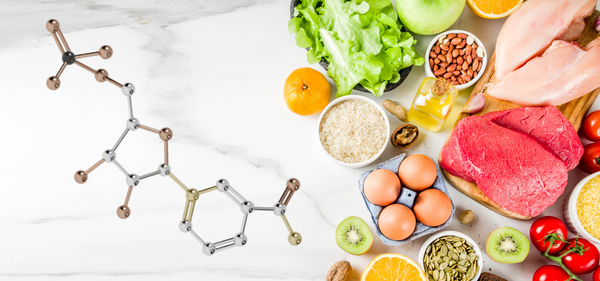FRUCTOSE – A WOLF IN SHEEP’S CLOTHING?

One of the most significant changes that comes with age is a more holistic approach to our health. It’s an overall commitment to maintaining our health over the long term through exercise, weight control, moderating our intake of fatty foods and generally looking after our bodies better than we may have done when we were younger.
One of the key areas that we need to manage is our blood sugar levels and avoiding the excessive insulin release resulting from the over-use of high GI foods.
We know that a bowl of porridge (Low GI) is a healthier option than a bowl of cornflakes (High GI). We covered High GI and Low GI foods in a previous article High GI or Low GI – What really works for athletes over 35?
However there are situations where the GI status of a carbohydrate isn’t the full story
The Humble Carrot
A 40 year old man steps on a weighing scale. His weight is 90kg. Is he too heavy? Does he need to lose weight?
It’s hard to tell without at least knowing his height.
At 6ft 6 inches tall he’d measure as “normal” on the Body Mass Index (BMI), whereas if he was a foot shorter he’s be classed as “over weigh”.
Weight relative to height fills out the picture for us.
 The same principle can be applied to how we look at our diet in the context of Low GI and High GI foods – just like weight, they are only part of the equation.
The same principle can be applied to how we look at our diet in the context of Low GI and High GI foods – just like weight, they are only part of the equation.
The GI is a relative index – each food is measured in the context of an equivalent serving of 50g of glucose (sugar). The humble and otherwise healthy carrot has a relatively high GI of 71 – that’s a fraction higher than Coke. However to get 50g of carbs from a serving of carrots would require nearly 600g of carrots. A can of Coke can deliver a 50g sugar payload in a 500ml bottle or one & a half 330 ml cans.
So in many cases we need to look at the portion size as well as the relative GI of a product to determine whether it’s going to have a significant negative impact on our blood sugar levels.
 Some foods with relatively low GI scores work against our system in other ways. Take fructose – a common ingredient in traditional sports nutrition products. It’s technically low GI at 19, however its used in sports nutrition products because it facilitates rapid energy release. How is this possible with a low GI value?
Some foods with relatively low GI scores work against our system in other ways. Take fructose – a common ingredient in traditional sports nutrition products. It’s technically low GI at 19, however its used in sports nutrition products because it facilitates rapid energy release. How is this possible with a low GI value?
Most of the carbohydrates we eat are made up of chains of glucose. When glucose enters the bloodstream, the body releases insulin to help regulate it. Depending on the carbohydrate – High GI or Low GI – and the quantity consumed, we will experience different rates of absorption. All normal so far. Fructose, which has a very low GI value of 19 would appear to be a good choice over something like Sucrose (63 GI) or Glucose (100 GI).
The trouble with fructose is the low GI value is achieved by avoiding the blood stream and going straight to the liver for processing. Most carbohydrates are broken down in the blood stream via the insulin response – Fructose is broken down in the liver and used to top-up its limited glycogen stores rather than fuel our muscles directly via the blood stream.
In small quantities this isn’t a problem, however when too much dietary fructose enters the liver, the liver can’t process it fast enough for the body to use as fuel. Instead, it starts making fats from the fructose and we see a rise in triglycerides in the blood stream. Triglycerides are the form in which most fat is stored in the body.
So where does all that leave us
+ Focus on Low GI carbohydrates as a good place to start.
+ Watch the Glycaemic Load – some high GI but otherwise healthy foods can be eaten in moderate portions without significantly impacting on your blood sugar levels
+ Avoid large quantities of fructose – the body’s ability to process it is limited to the capacity of your liver and any excess turns quickly to fat.
References
Insulin Resistance as a Predictor of Age-Related Diseases, Facchini et al., 2000
Human Nutrition Unit, School of Molecular Bioscience, University of Sydney
Dr. David L Katz, MD MPH FACPM FACP “Use and Abuse of the Glycemic Index”
The American Journal of Clinical Nutrition, “How Bad is fructose?” George A Bray
American Journal of Clinical Nutrition, 2000 Nov: “Effect of dietary fructose on plasma lipids in healthy subjects” Bantle JP., Raatz SK., Thomas W., Georgopoulos A..
About Elivar
Elivar – Sports Nutrition optimised for athletes over 35 year old. Our bodies change as we age, so should our sports nutrition. Try our Weekend Endurance Pack – fuel a weekend’s training with a selection of our Endure, Recover and Hydrate products for only £12.99 Try Now
Elivar’s products are 100% Gluten Free.
Also in News

A Huge Thank You - A Message From Donal & Len
We are writing to let you know that today marks the beginning of our FINAL SALE at Elivar.
Since our founding in 2012, we’ve been driven by the belief that there’s a healthier way to approach sports nutrition for everyday athletes—those of us who exercise as part of a balanced, healthy lifestyle.
We created award-winning products that provided energy without the sugar rush typical of mainstream brands. Our unique blends were designed to support post-exercise recovery, especially as our bodies changed over time.

Elivar's Sustain Go! Energy Gels Fuelling BigFeat Events' Success
BigFeat Events, recognized for orchestrating captivating endurance events, stands out for its dynamic blend of cycling and running sportives. The recent "Beast to the East" cycling sportive, held on May 21st, is a sterling example of their commitment to crafting exhilarating experiences. A cornerstone of the success and popularity of these events has been the provision of Sustain Go! energy gels, generously sponsored by Elivar.
Previous running and events such as the "Bigwayround Trail Run" and "BigSea Trail Run" also benefited from the free distribution of Sustain Go! energy gels, much to the participants' delight. The energy boost and quicker recovery offered by these gels have consistently been instrumental in empowering athletes to perform their best.

NMN: Boosting Your Health from the Kitchen to the Medicine Cabinet
Did you know that Nicotinamide Mononucleotide (NMN), the star ingredient in numerous anti-aging supplements, also moonlights in several foods you might already enjoy? It's true! NMN is a vital precursor to NAD+, a molecule crucial to many biological processes, like cell growth, DNA repair, and metabolism. But as we age, NAD+ levels take a hit, and bolstering them through NMN intake can be beneficial. Now the question arises, can we simply count on our daily meals for our NMN fix?
